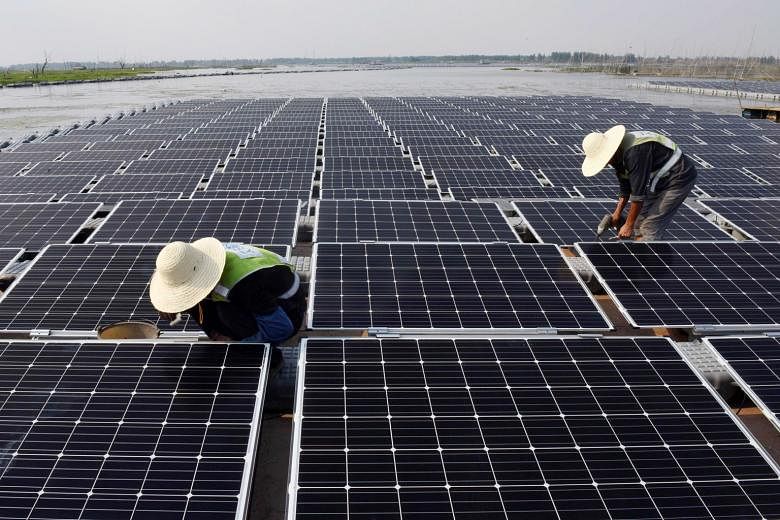The world waited with bated breath to see what Mr Donald Trump would do with the Paris climate agreement, but the reasons that ultimately drove him to abandon it were overwhelmingly domestic. As a candidate, his energy platform centred on the ideas that emissions reduction efforts hurt the American economy, "kill jobs", and weaken the country's energy security. After months of deliberation, the now-President decided there is no way to reconcile those "America First" policies with climate commitments that dictate terms to the US energy industry.
It must have come as a surprise then when fossil fuel companies came together to lobby the Trump White House not to tear up the pact. A pro-Paris alliance that included Cheniere Energy, ExxonMobil and even coal companies such as Cloud Peak and Peabody pleaded with the administration in support of the agreement before he decided to withdraw. Was this a sudden outburst of environmentalist altruism? Not quite.
Those companies, and especially America's struggling coal industry, are painfully aware that new emissions reduction technologies are the only way to remain competitive in the global marketplace. The Paris Agreement carves out an important place for these, especially carbon capture and storage (CCS) and utilisation. According to the International Energy Agency, at least 14 per cent of the emissions reductions required to meet the COP21's (21st Conference of the Parties) benchmarks must come from carbon capture, meaning the market for it is worth billions.
With the United States out of the Paris Agreement, developing nations are set to lose the billions Washington would have contributed to the Green Climate Fund. With that windfall now off the table, these countries will probably expand their reliance on their natural resources (such as coal), hoping to obtain the Western technology to develop it; only the US, Canada and Norway have large-scale CCS projects in operation at the moment.
Much of the demand for such technology is in Asia, where coal remains the cornerstone of energy grids and development efforts even as the industry struggles in the US. Both China and India have decided the best way to balance their energy needs with COP21 climate commitments is to reduce emissions while maintaining coal-fired plants as part of a balanced energy mix. Many of their neighbours will almost certainly follow suit.
That is why American coal companies see developing and exporting carbon capture to Asia's emerging markets as their last, best hope to remain competitive and expand. Key political figures from coal states, such as Senator Joe Manchin of West Virginia, have pushed this view as well. Mr Trump himself promised to support developing carbon capture when he was a candidate campaigning on a "clean coal" platform. His Secretary of Energy, Mr Rick Perry, helped inaugurate the government-backed Petra Nova carbon capture project in Texas less than two months ago.

But Beijing is also pressing ahead with its own clean coal research, sparking fears that American companies will be left completely behind. If this narrative sounds familiar, it is because it has happened before. Over the past 10 years, China surpassed both the US and the rest of the world in manufacturing wind and solar energy equipment, crowding out American and European competitors. With carbon capture technologies added to that mix, China could soon be positioned as the world's indispensable clean energy broker, at the direct expense of the US, which is at risk of being replaced.
For all the COP21's insistence on international cooperation, competition in the energy sector continues in true zero-sum fashion. When the US wanes, China waxes. Beijing is already set to outpace North America in large-scale CCS projects with a projected 330GW of CCS-compatible coal capacity online by 2020. The two countries have thus far been working together to make carbon capture technology feasible and economically viable on a large scale, with the Obama administration creating the US-China Clean Energy Research Centre to that end. American research may take a step back under Mr Trump, but the growing middle-class environmentalist movement and Communist Party fears of grassroots backlash over pollution are keeping "clean coal" at the heart of Chinese energy policy.
As a result, it's Chinese and not American companies that are primed to dominate the global market for carbon capture.
The largest of those is likely India, which is striving to cut carbon emissions without having to stomach cuts to energy production. A major component of India's answer has been to take old, inefficient coal plants and upgrade them with "supercritical" plants that promise greater efficiency and lower emissions; 40GW worth of coal plants are undergoing this upgrade.
Energy Minister Piyush Goyal has repeatedly stressed that India needs a stable baseload of coal-fired energy to make up for the sporadic nature of renewables, and that Indian consumers cannot be expected to forgo coal power when Western economies used it to develop for centuries. Those policies make India a natural customer for carbon capture technologies, and disagreement between India and China over investment reciprocity would further make it an excellent market for American coal companies as the technology progresses.
Then again, that ball isn't entirely in America's court. With the One Belt, One Road (Obor) project, China's President Xi Jinping and his economic planners are proactively creating captive markets for Chinese energy companies in both Asia and Africa. Key cogs of Obor, like Pakistan, are already partnering with China on major coal energy projects. American companies will have to work overtime to grab a slice of the cake. If Mr Trump wants to keep that from happening, he should remember that withdrawing from the COP21 won't undo the market forces it has helped unleash.
- Rob Edens is an Asean-focused researcher working out of London.

